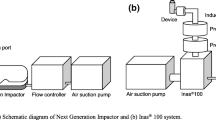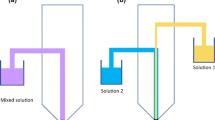Abstract
The aim of this research was to determine the reference ultrasonic velocity (v) and attenuation coefficient (α) for 2H, 3H-perfluoropentane (HPFP), 1,1,1,2-tetrafluoroethane (HFA-134a) and 1,1,1,2,3,3,3-tetrafluoroethane (HFA-227) propellants, for the future purpose of characterising pressurised metered dose inhaler (pMDI) formulations using high-resolution ultrasonic spectroscopy (HRUS). Perfluoroheptane (PFH) was used as a reference material for HPFP. With its velocity and attenuation coefficient determined at 25 °C, HPFP was subsequently used as a reference for HFA-134a and HFA-227. It was found that there is a linear decline in ultrasonic velocity with an increase in temperature. As with HPFP, the ultrasonic velocity of HFA-134a and HFA-227 were successfully calculated at 25 °C. However, the difference in density and viscosity between reference and sample prevented accurate determination of reference attenuation coefficient for the hydrofluoroalkanes. With ultrasonic velocity alone, dispersion concentration and stability monitoring for experimental pMDI formulations is possible using HRUS. However, at this point in time measurement of particle size is not feasible.





Similar content being viewed by others
References
F. Alba, G. M. Crawley, J. Fatkin, D. M. J. Higgs, and P. G. Kippax. Acoustic spectroscopy as a technique for the particle sizing of high concentration colloids, emulsions and suspensions. Colloids Surf A Physicochem Eng Asp. 153:495–502 (1999).
Z. Ma, H. G. Merkus, J. G. A. E. de Smet, C. Heffels, and B. Scarlett. New developments in particle characterization by laser diffraction: size and shape. Powder Technol. 111:66–78 (2000).
S. A. Jones, G. P. Martin, and M. B. Brown. High-pressure aerosol suspensions—A novel laser diffraction particle sizing system for hydrofluoroalkane pressurised metered dose inhalers. Int J Pharm. 302:154–165 (2005).
J. Ziegler, and H. Wachtel. Comparison of cascade impaction and laser diffraction for particle size distribution measurements. J Aerosol Sci. 18:311–324 (2005).
W. T. J. Kwong, S. L. Ho, and A. L. Coates. Comparison of nebulized particle size distribution with Malvern laser diffraction analyzer versus Andersen cascade impactor and low-flow Marple personal cascade impactor. J Aerosol Med. 13:303–314 (2000).
C. Lemarchand, P. Couveur, C. Vauthier, D. Constantini, and R. Gref. Study of emulsion stabilization by graft copolymers using the optical analyzer Turbiscan. Int J Pharm. 254:77–82 (2003).
O. Mengual, G. Meunier, I. Cayre, K. Puech, and P. Snabre. Characterisation of instability of concentrated dispersions by a new optical analyser: the TURBISCAN MA 1000. Colloids Surf A Physicochem. Eng. Asp. 152:111–123 (1999).
R. Ashayer, P. F. Luckham, S. Manimaaran, and P. Rogueda. Investigation of the molecular interactions in a pMDI formulation by atomic force microscopy. Eur. J. Pharm. Sci. 21:533–543 (2004).
H. D. Smyth. The influence of formulation variables on the performance of alternative propellant-driven metered dose inhalers. Adv. Drug. Deliv. Rev. 55:807–828 (2003).
S. A. Jones, G. P. Martin, and M. B. Brown. Manipulation of beclomethasone-hydrofluoroalkane interactions using biocompatible macromolecules. J. Pharm. Sci. 95:1060–1074 (2006).
P. G. Rogueda. HPFP, a Model Propellant for pMDIs. Drug Dev. Ind. Pharm. 29:39–49 (2003).
R. O. Williams 3rd, M. A. Repka, and M. K. Barron. Application of co-grinding to formulate a model pMDI suspension. Eur. J. Pharm. Biopharm. 48:131–140 (1999).
Y. Michael, M. J. Snowden, B. Z. Chowdhry, I. C. Ashurst, C. J. Davies-Cutting, and T. Riley. Characterisation of the aggregation behaviour in a salmeterol and fluticasone propionate inhalation aerosol system. Int. J. Pharm. 221:165–174 (2001).
A. Brindley. The chlorofluorocarbon to hydrofluoroalkane transition: the effect on pressurised metered dose inhaler stability. J. Allergy Clin. Immunol. 104:S211–226 (1999).
A. S. Dukhin, and P. J. Goetz. Ultrasound for characterising colloids—Particle sizing, Zeta Potential, Rheology, Elsevier Science B.V., Amsterdam, 2002.
U.S. Department of Health and Human Services, Food and Drug Administration, Center for Drug Evaluation and Research (CDER), Center for Veterinary Medicine (CVM), Office of Regulatory Affairs (ORA). Guidance for Industry PAT—A Framework for Innovative Pharmaceutical Development, Manufacturing, and Quality Assurance http://www.fda.gov/Cder/guidance/6419fnl.pdf.
V. A. del Grosso, and C. W. Mader. Speed of Sound in Pure Water. J. Acoust. Soc. Am. 52:1442–1972 (1972).
T. A. Litovitz. Ultrasonic spectroscopy in liquids. J. Acoust. Soc. Am. 11:681–691 (1959).
V. A. Buckin, E. Kudryashov, and B. O’Driscoll. High-resolution ultrasonic spectroscopy for material analysis. Am. Lab. 34:28, 31–32 (2002).
J. R. Allegra, and S. A. Hawley. Attenuation of sound in suspensions and emulsions: Theory and experiments. J. Acoust. Soc. Am. 51:1545–1564 (1971).
L. Lehmann, and V. Buckin. Determination of the heat stability profiles of concentrated milk and milk ingredients using high resolution ultrasonic spectroscopy. J. Dairy. Sci. 88:3121–3129 (2005).
V. A. Buckin, and C. Smyth. High-resolution ultrasonic resonator measurements for analysis of liquids. Semin. Food Anal. 4:89–105 (1999).
U. Riebel, and F. Löffler. The fundamentals of particle size analysis by means of ultrasonic spectrometry. Part Part Syst. Charact. 6:135–143 (1989).
P. G. Rogueda, V. Buckin, and E. Kudryashov. Size and concentration monitoring of hfa suspensions. Respiratory Drug Delivery X. April 23–27, 2006; Boca Raton, FL
A. Goebel, and K. Lunkenheimer. Interfacial tension of the water/n-alkane interface. Langmuir. 13:369–372 (1997).
Acknowledgements
The authors gratefully acknowledge the financial support from the Faculty of Pharmacy at the University of Sydney (Australia) and AstraZeneca R&D Loughborough (UK).
Author information
Authors and Affiliations
Corresponding author
Rights and permissions
About this article
Cite this article
Hoe, S., Young, P.M., Rogueda, P. et al. Determination of Reference Ultrasound Parameters for Model and Hydrofluoroalkane Propellants Using High-Resolution Ultrasonic Spectroscopy. AAPS PharmSciTech 9, 605–611 (2008). https://doi.org/10.1208/s12249-008-9087-z
Received:
Accepted:
Published:
Issue Date:
DOI: https://doi.org/10.1208/s12249-008-9087-z




